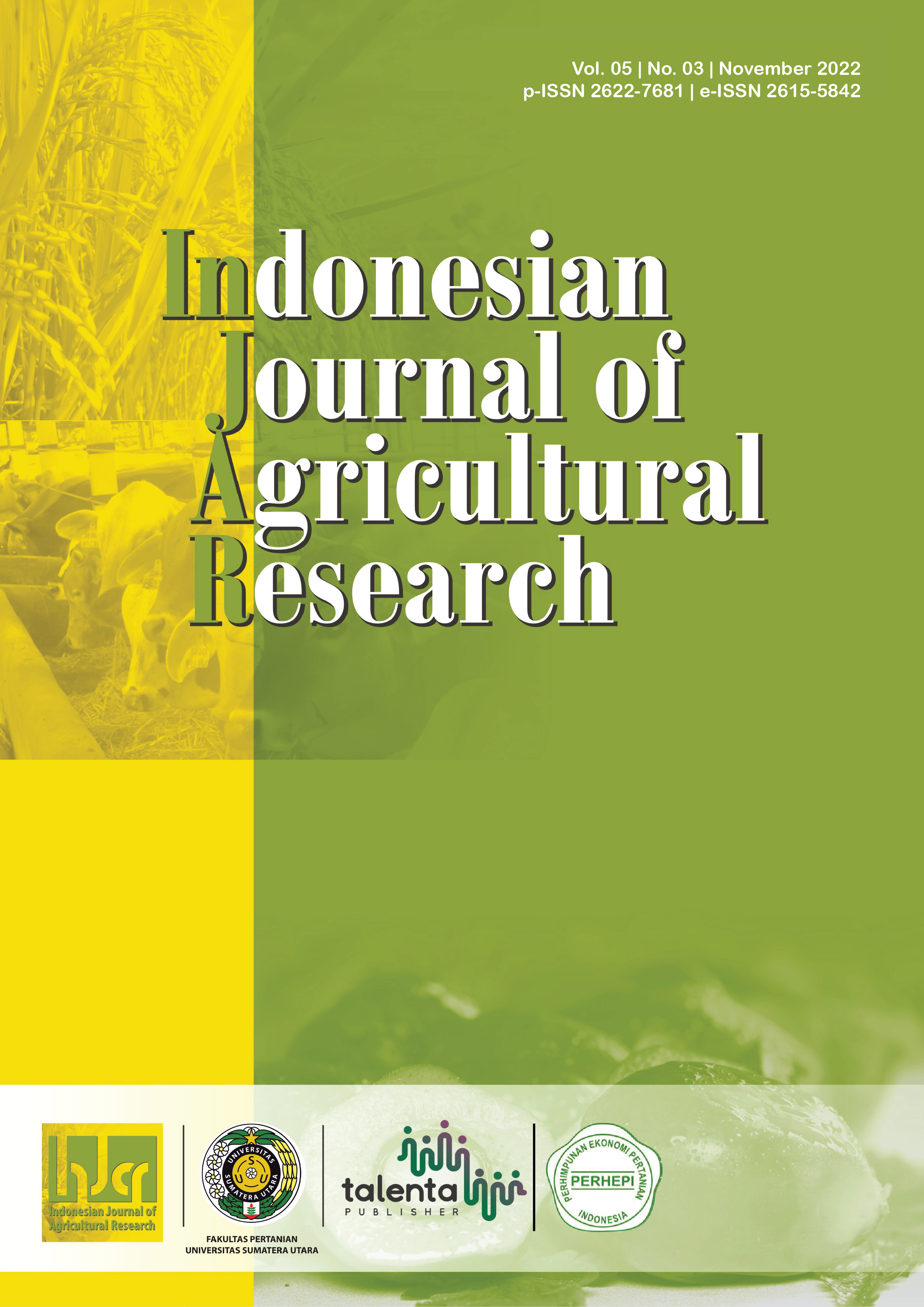Feasibility Analysis of Patchouli Farming Business In Burana Village, Tabulahan District, Mamasa Regency
DOI:
https://doi.org/10.32734/injar.v5i03.9409Keywords:
farming business costs, business feasibility, profit, revenueAbstract
Patchouli has begun to be widely cultivated by farmers in Burana Village with its easy cultivation and offer a promising profit. This study aims to determine whether or not it is feasible to develop a patchouli farming business in this area. Quantitative research is used to anlyze farm costs, farming profits, farm income, return cost ratio (R/C), capital productivity (n/C) and break-even point analysis (BEP). The results showed that the average area of farmers' land is 47.22 acres, so the average cost of production on patchouli farming is Rp. 23,521,073, and the average revenue obtained is Rp. 30,486,379, then the average profit for each respondent is Rp. 6,965,306, so the R/C ratio obtained is 1.3 because the value of the R/C ratio is greater than 1, so patchouli farming is feasible. The value of π/C 0.29 indicates a profitable business where each additional cost of Rp. 100 then a profit of Rp. 29 (29%). The analysis of break-even point for the production volume in patchouli farming is 53,458 kg, meaning that at 53,458 kg the patchouli business is profitable because the patchouli product number of 53,456 kg is below the average product figure of 69.998 kg. Analysis of the point of return for the cost of production in patchouli farming is Rp. 336,025 shows that it is still below the market price of Rp. 439,995, means that the patchouli business is profitable.
Downloads
References
Umikalsum, “Analisis Pendapatan dan Kelayakan Ekonomi Usaha Tani Padi di Daerah Agropolitan Kel. Pulokerto Kec. Gandus Palembang,†AgrIBA, vo.l 3, no. 1, pp.14-21, 2013.
United Nations Comtrade Database, “Indonesia Patchouli Oil Export Trade Flows 2001- 2018,†[Online]. Available: http://comtrade.un.org, 2019.
A. Bimo. “Harga Minyak Nilam Naik Hampir 2 Kali Lipat Dalam Sepekan Terakhir,†kompas.tv. https://www.kompas.tv/article/99123/harga-minyak-nilam-naik-hampir-2-kali-lipat-dalam-sepekan-terakhir (accessed July. 1, 2022.
Nasir, A. “Kecamatan Tabulahan Dalam Angka 2019,†Badan Pusat Statistik Kabupaten Mamasa. BPS; 2019.
Kasmir and Jakfar, “Studi Kelayakan Bisnis,†Jakarta: Kencana, 2012.
V. Heriati, “Analisis Pendapatan Pada Usaha Tani Nilam di Desa Terpedo Jaya Kecamatan Sabbang Kabupaten Luwu Utara,†Skripsi, Prodi. Manajemen, Univ. Muhammadiyah Makassar, 2020.
S. Astuti, “Produktivitas Tanaman Nilam ( Pogestemon cablin Benth ) pada Hutan Rakyat di Desa Leling Utara Kecamatan Tommo Kabupaten Mamuju,†Skripsi, Prodi. Kehutanan, Univ. Muhammadiyah Makassar, 2019.
Asnidar and Asrida, “Analisis Kelayakan Usaha Home Industry Kerupuk Opak Di Desa Paloh Meunasah Dayah Kecamatan Muara Satu Kabupaten Aceh Utara,†S. Pertanian, vol. 1, no. 1, pp. 42-43, 2017.
N. Saidin, “Model Produktivitas, Risiko dan Perilaku Petani Menyikapi Risiko Produksi Usahatani Padi Sawah di Kabupaten Tebo,†Jurnal Ilmiah Sosio-Ekonomi Bisnis, vol. 24, no. 2, 2021.
Y. Efendi, “Analisis Usahatani Tomat (Lycopersicone esculentum Mill) di Desa Mandesan Kecamatan Selopuro Kabupaten Blitar,†Jurnal Viabel Pertanian, vol. 10, no. 2, pp. 51-61, 2016.
Downloads
Published
How to Cite
Issue
Section
License
Copyright (c) 2023 Indonesian Journal of Agricultural Research

This work is licensed under a Creative Commons Attribution-ShareAlike 4.0 International License.



















